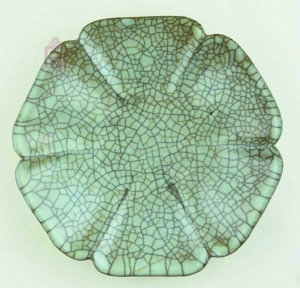(Ecns.cn)--The Palace Museum in Beijing's Forbidden City admitted on Sunday that a rare piece of grade-one cultural relic had been damaged during research activities.
The incident occurred on July 4 while researchers were conducting tests and analysis on the antique, but the Palace Museum did not immediately report it to the public or authorities.
On July 30, a web user named "Long Can" disclosed the incident on his microblog, saying that a researcher at the Palace Museum accidentally damaged a piece of porcelain and the museum had been trying to cover up the incident.
The message attracted a lot of attention from Web users, and on July 31, the museum published a statement admitting the damage and saying that the incident is still under investigation.
Preliminary investigation
The 1,000-year-old Ge Kiln porcelain plate called "Celadon Plate with a Mouth in the Shape of Mallow Petals," was crushed and damaged on July 4 when a laboratory researcher used a device to examine it.
The researcher stopped the operation immediately after she discovered the problem and reported the incident to her senior officials in the museum. The device was removed from usage and underwent testing soon after the researcher informed officials of this incident.
The museum organized a special investigative team after the incident and following repetitive tests and discussions, the expert panel gave a preliminary report on the incident on July 21, saying that the damage was a human error caused by carelessness.
The researcher input the wrong data into the machine, causing the device to rise excessively and squeeze the plate, according to the preliminary investigative report. The report also includes proposals to improve work and prevent future accidents.
The device is designed to examine ancient ceramics in the museum and began to be used in 2005. Last year, researchers used this machine to examine porcelain products from the five most famous kilns in the Song Dynasty (960 to 1279). The 50 pieces of porcelain that have been examined already remain intact and the examinations were conducted smoothly.
The researcher who is mainly responsible for the damage has been working in the museum since 2004 and is among the first group of personnel to have used this machine. Her previous work was good, and she is very sad about this error.
The punishment for those responsible is under discussion, the statement said.
The preliminary report on this incident, filed on July 21, will be submitted to the Ministry of Culture and the State Administration of Cultural Heritage (SACH) as soon as a more detailed report is completed.
According to the law on the protection of cultural relics, museums should report any damage to grade-one antiquities in their collection to senior top culture authorities. But the museum did not report the incident until 26 days after the incident.
Though some question whether the museum was trying to hide the incident, the museum has denied this intention. As the law did not specify how soon the matter should be referred to SACH, they say they wanted to use one month to investigate the incident and draft a method to prevent future accidents from occurring.
"As the incident caused great damage to the relic, we need time to investigate every detail," said Miao Jianmin, a senior official from the museum.


















